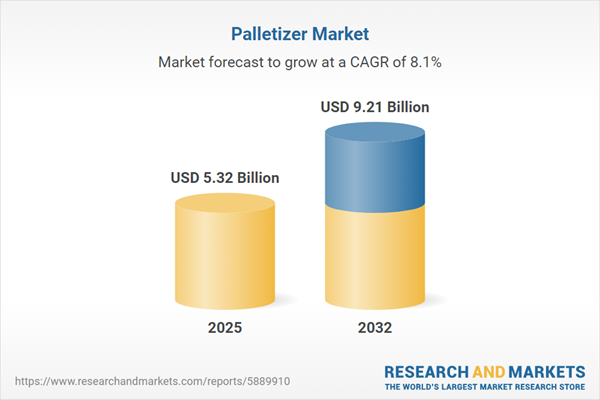Speak directly to the analyst to clarify any post sales queries you may have.
Senior executives seeking to optimize operational agility and enhance supply chain resilience are turning to palletizer automation as a crucial strategy. As organizations face evolving market conditions, a precise approach to automation enables better risk management, future-proofs logistics, and empowers streamlined operations throughout the value chain.
Palletizer Market Snapshot: Growth and Opportunities
The palletizer market is experiencing accelerated expansion, fueled by robust investments in robotics, end-of-line automation, and digital transformation. In 2024, the global palletizer market is valued at USD 4.92 billion, projected to reach USD 5.32 billion in 2025 and approximately USD 9.21 billion by 2032. This growth represents an 8.13% compound annual growth rate. The adoption trend is notably strong across sectors prioritizing high efficiency, such as pharmaceuticals, food and beverage, automotive, logistics, and retail. Leaders in these industries focus on modern palletizer systems featuring advanced controls, modular hardware, and software integrations. This modernization helps organizations implement agile production strategies, manage frequent product changes, ensure high uptime, and scale manufacturing as market conditions evolve. Ultimately, advanced palletizer automation supports businesses in creating more responsive and robust supply chains to navigate complex and unpredictable business landscapes.
Palletizer Market Scope & Segmentation
A well-defined segmentation approach is essential for senior leaders to align palletizer investments with technical requirements, operational workflows, and regulatory demands. Understanding market segments helps tailor automation to specific business models and achieve sustained value.
- End Use Industries: Automotive OEMs, chemical producers, consumer packaged goods manufacturers, pharmaceutical companies, diverse logistics and warehousing operators, food and beverage processors in bakery, dairy, and protein subsectors, as well as e-commerce, apparel, and electronics retailers all require custom palletizer solutions adapted to throughput, hygiene, and packaging specifications.
- Automation Levels: Both fully automatic and semi-automatic palletizer systems address varying organizational preferences for phased deployment, workforce integration, and capital planning.
- Technology Types: Layer pattern and random pattern palletizers provide options for businesses handling either uniform product runs or frequent SKU changes in complex, high-mix environments.
- Packaging Material Types: Laminated bags, paper bags, plastic containers, glass bottles, corrugated cases, and hybrid trays are supported, ensuring alignment with diverse packaging demands and product safety standards.
- Application Areas: Single-product production lines, high-mix manufacturing, and mixed-load operations benefit from scalable palletizer solutions optimized for both low- and high-volume sites.
- Payload Capacities: Solutions span a full range from low to high payloads, supporting different throughput goals and accommodating spatial or facility constraints in plant layouts.
- Regions Covered: Americas, Europe, Middle East and Africa, and Asia-Pacific are represented, each with unique compliance requirements, procurement landscapes, and operational environments.
- Representative Companies: Major industry suppliers—KION Group, Daifuku, SSI Schaefer, Beumer Group, ABB Ltd., FANUC, KUKA, Yaskawa Electric, Comau, and Fives Group—shape global and regional solutions in line with client-specific requirements.
Palletizer Market: Key Takeaways for Senior Decision-Makers
- Automated palletizers help bridge labor shortages and maintain consistent efficiency across distributed operations, reducing the risk of disruptions from workforce variability.
- Integrating Industrial IoT in palletizer systems gives leaders real-time insights, making it easier to adjust to production shifts and manage complex fulfillment cycles.
- Choosing systems designed for energy efficiency and predictive maintenance supports sustainability objectives, lengthens equipment lifespans, and minimizes unplanned downtime.
- Flexible palletizer platforms and collaborative automation facilitate safe deployment and swift adaptation to changes in production or packaging requirements.
- Integration with digital twins and secure cloud technology enables ongoing modernization, virtual system design validation, and alignment with evolving IT strategies.
- Regularly updating procurement and compliance protocols to meet shifting regulations sustains operations and reduces the exposure to market or geopolitical risks across multiple regions.
Tariff Impact and Supply Chain Shifts
Adjustments in U.S. tariffs on imported palletizer equipment are prompting firms to review sourcing, procurement, and supplier diversification strategies. Many organizations are responding by expediting automation projects and evolving supply relationships. These shifts ultimately improve resilience to market disruptions and regulatory changes, supporting more robust supply chain strategies while managing risk across global and regional markets.
Methodology & Data Sources
This report is based on comprehensive secondary research, specialized inputs from automation experts, and direct technical evaluations of leading palletizer technologies. Onsite investigations and peer assessments support the accuracy and relevance of key findings, aligning with the decision-making needs of senior executives.
Why This Report Matters
- Supports executive teams in addressing dynamic market challenges, staying compliant, and achieving sustainability benchmarks through strategic palletizer investments.
- Provides procurement and logistics leaders with practical guidance to navigate tariffs, streamline supplier management, and adapt to evolving market conditions.
- Translates organizational goals into actionable recommendations for advancing, scaling, and optimizing automation initiatives throughout the enterprise.
Conclusion
Senior leaders can rely on this report to make informed choices in palletizer automation, advancing sourcing, risk mitigation, and operational performance in complex market environments.
Additional Product Information:
- Purchase of this report includes 1 year online access with quarterly updates.
- This report can be updated on request. Please contact our Customer Experience team using the Ask a Question widget on our website.
Table of Contents
3. Executive Summary
4. Market Overview
7. Cumulative Impact of Artificial Intelligence 2025
Companies Mentioned
The companies profiled in this Palletizer market report include:- KION Group Aktiengesellschaft
- Daifuku Co., Ltd.
- SSI Schaefer Holding GmbH
- Beumer Group GmbH & Co. KG
- ABB Ltd.
- FANUC Corporation
- KUKA Aktiengesellschaft
- Yaskawa Electric Corporation
- Comau SpA
- Fives Group S.A.
Table Information
| Report Attribute | Details |
|---|---|
| No. of Pages | 180 |
| Published | October 2025 |
| Forecast Period | 2025 - 2032 |
| Estimated Market Value ( USD | $ 5.32 Billion |
| Forecasted Market Value ( USD | $ 9.21 Billion |
| Compound Annual Growth Rate | 8.1% |
| Regions Covered | Global |
| No. of Companies Mentioned | 11 |









